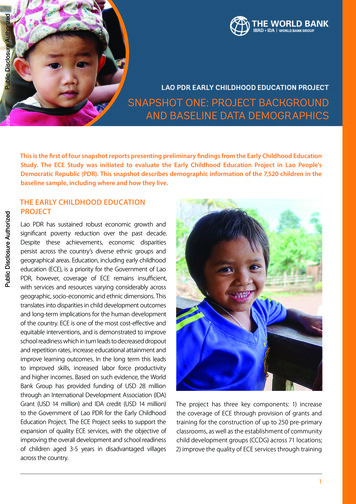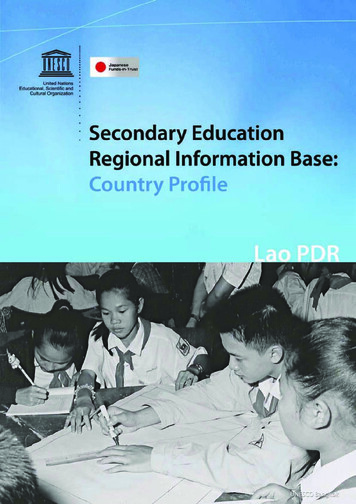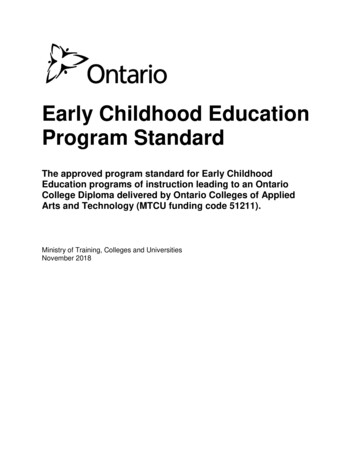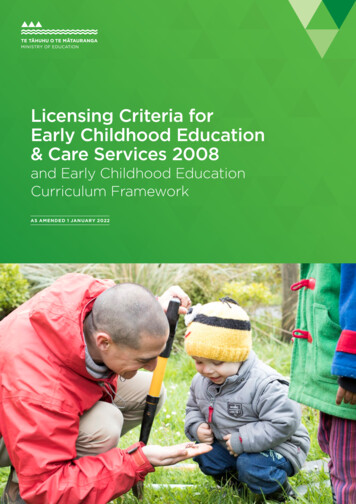
Transcription
Public Disclosure AuthorizedPublic Disclosure AuthorizedPublic Disclosure AuthorizedPublic Disclosure AuthorizedLAO PDR EARLY CHILDHOOD EDUCATION PROJECTSNAPSHOT ONE: PROJECT BACKGROUNDAND BASELINE DATA DEMOGRAPHICSThis is the first of four snapshot reports presenting preliminary findings from the Early Childhood EducationStudy. The ECE Study was initiated to evaluate the Early Childhood Education Project in Lao People'sDemocratic Republic (PDR). This snapshot describes demographic information of the 7,520 children in thebaseline sample, including where and how they live.THE EARLY CHILDHOOD EDUCATIONPROJECTLao PDR has sustained robust economic growth andsignificant poverty reduction over the past decade.Despite these achievements, economic disparitiespersist across the country’s diverse ethnic groups andgeographical areas. Education, including early childhoodeducation (ECE), is a priority for the Government of LaoPDR, however, coverage of ECE remains insufficient,with services and resources varying considerably acrossgeographic, socio-economic and ethnic dimensions. Thistranslates into disparities in child development outcomesand long-term implications for the human developmentof the country. ECE is one of the most cost-effective andequitable interventions, and is demonstrated to improveschool readiness which in turn leads to decreased dropoutand repetition rates, increase educational attainment andimprove learning outcomes. In the long term this leadsto improved skills, increased labor force productivityand higher incomes. Based on such evidence, the WorldBank Group has provided funding of USD 28 millionthrough an International Development Association (IDA)Grant (USD 14 million) and IDA credit (USD 14 million)to the Government of Lao PDR for the Early ChildhoodEducation Project. The ECE Project seeks to support theexpansion of quality ECE services, with the objective ofimproving the overall development and school readinessof children aged 3-5 years in disadvantaged villagesacross the country.The project has three key components: 1) increasethe coverage of ECE through provision of grants andtraining for the construction of up to 250 pre-primaryclassrooms, as well as the establishment of communitychild development groups (CCDG) across 71 locations;2) improve the quality of ECE services through trainingLAO PDR EARLY CHILDHOOD EDUCATION PROJECT SNAPSHOT ONE: PROJECT BACKGROUND AND BASELINE DATA DEMOGRAPHICS1
for teachers, caregivers and community members,the development of training and pedagogical materials,as well as the provision of support services such asdisability screening and school lunches; and 3) projectmanagement, capacity development, and monitoringand evaluation at all levels of ECE.Included within the scope of the funding to theGovernment of Lao PDR is an independent evaluationof the project’s impact on a range of child outcomes,including both cognitive and non-cognitive development.As part of the evaluation, data has been collected acrossthe northern provinces of Lao PDR to provide informationon the current status of ECE participation and childoutcomes prior to the project’s implementation. This is thefirst of four snapshots developed to present results fromthe baseline data collection. This first snapshot presentsinformation on the social, demographic and economicsituation of families with young children in NorthernLao PDR, the second snapshot presents information onthe health and nutrition of children, the third providesinformation on the skills, knowledge and developmentof children, and the fourth provides information onavailability, access and use of services that support earlychildhood health and education.2FIGURE 1. PROVINCES IN WHICH BASELINE DATAWERE MXAYVIENTIANE CAPITALLAO PDR EARLY CHILDHOOD EDUCATION PROJECT SNAPSHOT ONE: PROJECT BACKGROUND AND BASELINE DATA DEMOGRAPHICS
BASELINE DATA COLLECTIONBaseline data were collected from November 2015 toMarch 2016 from families in 7,355 households acrossfive provinces, 14 districts and 376 villages in NorthernLao PDR (see Table 1). There were 7,520 childrenwho completed a direct assessment measuring theirdevelopment, while their primary caretakers providedinformation on child health, nutrition, development,education and parenting practices. Data were alsocollected from each village and household head,including family demographic information and theavailability of services and facilities in each village.Together, these data provide a comprehensive pictureof the environments in which children in Northern LaoPDR are growing up, and how these environmentsimpact children’s early development.VILLAGESVillage access: Villages were relatively remote, and whilealmost all could be accessed by car in the dry season (97%),only just over half could be accessed by car in the wetseason (53%).TABLE 1. NUMBER OF VILLAGES AND CHILDRENFROM EACH DISTRICT AND PROVINCEPROVINCEDISTRICTNUMBER OFVILLAGESNUMBER y36720Houa Meoung42840Xam Tai36720Sobbao39780Meoung xaySaychamphone17340Electricity: More than half of the villages accessedelectricity from government electrical grids (55%), 32%of villages had a mini hydropower generator supportingtheir households, 8% used solar cells, 1% used batterygenerators, and less than 1% had a private electricalgenerator. A small number of villages (4%) did not haveaccess to electricity.Water: The majority of villages used drinking waterLAO PDR EARLY CHILDHOOD EDUCATION PROJECT SNAPSHOT ONE: PROJECT BACKGROUND AND BASELINE DATA DEMOGRAPHICS3
6% experienced flood, 2% experienced a storm andanother 2% experienced aridity. Additionally, a fewvillages experienced robbery or damage to a bridge(each 1%). On the positive side, 15% had new schoolsestablished, 8% had new roads built and 2% had a newhealth center established. The establishment of a newpre-primary classroom, a new teacher house, a newfactory/industry, electricity for the community, a canteenroom for children at school, a new temple, a market ora new village office were experienced by 1% of villages.HOUSEHOLDSComposition: Households ranged in size from 2–21members, with the majority of households comprising2–5 members (41%) or 6–10 members (52%). A smallernumber of households had 10–15 members (7%), andfewer than 1% of households had 16–21 members.from trenches/drainage pipes (90%), while 91% alsoused this same water source for washing and cleaning.Villages reported using river water for drinking (39%) andwashing/cleaning (62%), as well as container water fordrinking (23%). Few villages reported using well water fordrinking (9%) and washing/cleaning (11%), undergroundwater for drinking (4%) and washing/cleaning (5%) andrainwater for drinking (1%) and washing/cleaning (5%).Sanitation: Villages were often using a combinationof sanitation processes, with 93% of villages having somehouseholds using pit toilets with a water flush, 21% ofvillages had some households using a dry pit, and 68% ofvillages had some households that were not using toilets.Important Events: While 44% of village heads reportedthat no important events had occurred in the village inthe past three years, 32% of villages had experiencedcrop damage, 9% experienced an epidemic, 9%experienced landslides, 6% experienced fire and another4Building Materials: Houses were made from a rangeof different materials. The majority of roofs were madefrom tiles (51%) and zinc alum (32%), while some werealso made from grass (10%), wood (6%), leaves (2%) andconcrete ( 1%). Most house walls were made from wood(65%), while some were also made from bamboo (18%),bricks/cement (17%) and zinc alum or plywood ( 1%).Floors were made from wood (35%), dirt (28%), cement(23%), bamboo/leaves (9%), tiles (5%) and ceramic ( 1%).Socio-economic Status: Households were asked abouttheir assets in order to demonstrate socio-economicstatus. The majority of households (72%) reported owningagricultural land and at least one duck or chicken (80%),a motorcycle (76%), pig (71%) and mobile or landlinephone (75%). Many households also owned at least onecow or buffalo (50%), television (46%), a car, motor boator tractor (26%). Few households owned at least onegoat (11%), bicycle (10%), radio/cassette player (9%) andhorse (1%). Just 2% of households had experienced afood shortage for two consecutive days in the past 12months. Similarly, 4% of households had been unable topurchase enough clothes for their children in the past 12months, while another 4% had been unable to purchaseenough books, stationery and toys for their children inthe past 12 months.LAO PDR EARLY CHILDHOOD EDUCATION PROJECT SNAPSHOT ONE: PROJECT BACKGROUND AND BASELINE DATA DEMOGRAPHICS
CARETAKERSRelationship to the Child: The majority of caretakerssurveyed identified themselves as the mothers of thechildren being assessed (85%). The remainder were thechildren’s fathers (11%), grandparents (3%), aunts, unclesand siblings ( 1%).Age: Caretakers ranged in age from 14-78 years old,with the majority aged between 20-29 years (57%).28% were aged between 30-39 years and 15% aged 40 years or over.Education and Literacy: Overall, caretakers had loweducation and literacy levels, with 30% of caretakersnever having been to school, 27% had attended butnot completed primary school, 29% had completedprimary school, 8% had completed secondary school,2% had completed high school and less than 1% hadcompleted a bachelor degree. When asked to read ashort sentence in Lao, 45% of caretakers were not ableto read at all, 17% could read a little, and 38% could readthe sentence well.FIGURE 2. CARETAKER EDUCATION3%Completed Vocational TrainingCompleted High SchoolCompleted aBachelor Degree or similar1%2%Completed SecondarySchool8%CompletedPrimary School30%29%27%No schoolAttended but did notcomplete Primary SchoolFIGURE 3. CARETAKER LITERACYCan read well38%Can read a little17%45%Cannot read at allLAO PDR EARLY CHILDHOOD EDUCATION PROJECT SNAPSHOT ONE: PROJECT BACKGROUND AND BASELINE DATA DEMOGRAPHICS5
TABLE 2. AGE AND GENDER OF CHILDRENAGENUMBER OFCHILDREN (%)MALECHILDREN (%)FEMALECHILDREN (%)2 years old1,540 (21%)52%48%3 years old2,005 (27%)51%49%4 years old2,148 (29%)51%49%5 years old1,827 (24%)51%49%FIGURE 4. RENAge and Gender: Children ranged in age from 2–5years; 51% were male and 49% female. As demonstratedin Table 2 there was a roughly equivalent number ofchildren in each age group, as well as a roughly evennumber of males and females in each age group.Ethnicity: The majority of children were Lao-Tai (30%),Khmun (25%) and Hmong (27%). Other children were of27%Hmong25%Prai (5%), Phong (4%) and Akha (4%) ethnicities, while 1%or less of children were each Lao, Leu, Yang, Cingmoon,Kmer, Toum, Singsili, Hor or Ilmain ethnicities. Table 3below presents children’s ethnicities across the fiveprovinces.TABLE 3. NUMBER AND PERCENTAGE OF CHILDREN OF EACH ETHNICITY ACROSS PROVINCESETHNICITYPHONGSALY (%)OUDOMXAY (%)HOUAPHANH (%)Lao-Tai89 (18%)204 (11%)1806 (40%)5 (1%)Khmun215 (43%)1079 (60%)530 (12%)2 ( 1%)69 (20%)Hmong4 (1%)227 (13%)1738 (39%)1 ( 1%)73 (22%)Prai--1 ( 1%)368 (92%)-Phong--249 (6%)-11 (3%)163 (33%)167 (9%)----17 (1%)--1 ( 1%)AkhaLaoLeuXAYABOURY (%)BORLIKHAMXAY (%)123 (36%)3 (1%)53 (3%)--Yang16 (3%)----Cingmoon1 ( 1%)-79 (2%)24 (6%)-Kmer-27 (2%)--21 (6%)Toum----42 (12%)SingsiliHor9 (2%)21 (1%)----1 ( 1%)---Ilmain-3 ( 1%)77 (2%)--TOTAL500 (100%)1800 (100%)4480 (100%)400 (100%)340 (100%)6KhmunLAO PDR EARLY CHILDHOOD EDUCATION PROJECT SNAPSHOT ONE: PROJECT BACKGROUND AND BASELINE DATA DEMOGRAPHICS
NEXT STEPS FOR THE ECE STUDY:The results presented in this series of snapshot reportsrepresent the starting point (or “base line”) for theevaluation of the ECE Project. In 2018, the evaluationteam will conduct an “end line” survey to re-assess howwell children in the studied villages have developed.Information will also be collected on enrolment,attendance and performance of the children at school. Itis expected that after the project has been implementedfor a couple of years in the studied villages, the childrenwill have improved their health and developmentstatus, skills and knowledge. The success (or failure) ofthe project to improve early childhood developmentaloutcomes will be evaluated by comparing key outcomesof the children living in the villages where the projecthas been implemented with outcomes of children livingin other similar villages where the project has not beenimplemented.As explained earlier, there are three different componentsof the ECE Project and each of these elements will beevaluated separately. The three different components are:1 Community Child Development Groups, which includesthe delivery of community-based playgroups by traininglocally recruited “teachers” and building a CCDG hut2 Multi Age Teaching (MAT), which includes traininglocal pre-school teachers to deliver the ECE curriculumto children aged 3–5 years in one class, as well as theactual implementation of this approach3 Community Awareness Campaign (CAC), whichincludes an early childhood health and developmenttraining course provided to the local Village EducationDevelopment Committees, who will then undertakecommunity awareness training with parents in theirvillageEach of the different components of the ECE Projectshould have a positive impact on the health, developmentand skills of the children living in the villages. The resultsof the evaluation will inform the Government of Lao PDRabout the project’s effectiveness (what works and whatdoes not work to support child health and development),and help determine how to strengthen the quality ofhealth and education projects in Lao PDR.LAO PDR EARLY CHILDHOOD EDUCATION PROJECT SNAPSHOT ONE: PROJECT BACKGROUND AND BASELINE DATA DEMOGRAPHICS7
FUNDING FOR THIS INITIATIVE:Funding for the ECE Project is provided by the World Bank Group through an InternationalDevelopment Association (IDA) Grant and Credit under the Early Childhood Education Project(P145544). Further funding to support the production of this series of snapshot reports has beenprovided through a partnership between the World Bank, Plan International and Save the ChildrenInternational as part of the Lao Educational Access, Research and Networking (LEARN) Project,with funding from Dubai Cares under Externally Financed Output (EFO) Agreement EFO 990.The findings, interpretations and conclusions expressed in this brief do not necessarily representthe views of the Government of Lao PDR or the World Bank Group.Prepared by:Dr Sally Brinkman, Ms Alanna Sincovich, Mr Pedro Cerdan-Infantes, Mr Plamen Nikolov DanchevFor more information about the ECE Project, o-prd-early-childhood-developmentproject?lang enFor more information about the study results, please contact Sally Brinkman:sally.brinkman@telethonkids.org.auFor more information about the ECE Project, please contact Plamen Nikolov Danchev:pdanchev@worldbank.orgThe World Bank Country OfficePatouxay Nehru RoadP.O. Box: 345Vientiane, Lao PDRTel: (856-21) 266 200Fax: (856-21) 266 299www.worldbank.org/lao8Education Global PracticeThe World Bank1818 H Street, NWWashington D.C. 20433, USATel: (202) 4731000Fax: (202) 4776391www.worldbank.orgLAO PDR EARLY CHILDHOOD EDUCATION PROJECT SNAPSHOT ONE: PROJECT BACKGROUND AND BASELINE DATA DEMOGRAPHICS
LAO PDR EARLY CHILDHOOD EDUCATION PROJECT SNAPSHOT ONE: PROJECT BACKGROUND AND BASELINE DATA DEMOGRAPHICS 5 FIGURE 2. CARETAKER EDUCATION 30% No school Completed Primary School 29% Completed Secondary School 8% Completed Vocational Training 3% Completed High School 2% Completed a 1% Bachelor Degree or similar Attended but did not










